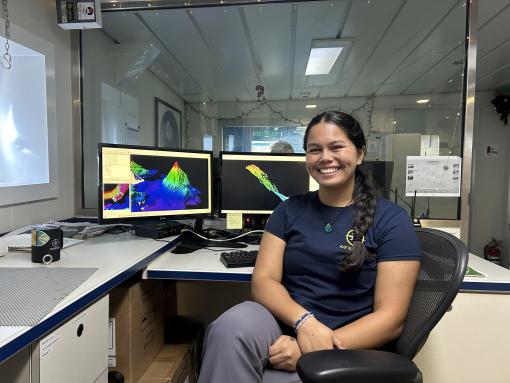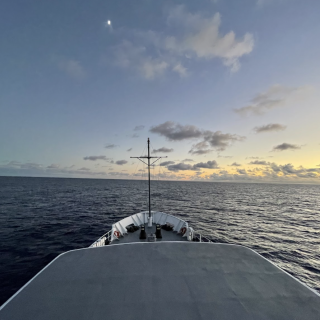Meet Ocean Explorer Julia Hill

OET proudly welcomes Julia Hill to the Corps of Exploration as part of the Science & Engineering Internship Program. This internship program supports community college, undergraduate, and graduate students in building professional workforce experience and exploring STEAM-related careers that connect to research themes like robotics, ocean science, education, and exploration. Julia is joining E/V Nautilus for our NA166 expedition as a seafloor mapping intern.
We sat with her to learn more about her experience at sea and the path that led her to Nautilus.
Describe your role with OET.
During this expedition on the E/V Nautilus I am a Seafloor Mapping and Hydrography Intern. I help map the seafloor beneath us as we are in transit to our offshore sites near Howland and Baker Islands in the US EEZ. We use multibeam sonar to collect our data and deploy an expendable bathythermograph (XBT) to acquire the sound velocity for accurate sonar mapping.
Can you tell us a little about your background? What influenced you as a child?
I was born and raised in San Diego, CA, before attending the University of Hawai’i at Hilo to receive my bachelor's in Marine Science. I only really started getting into mapping and geology after taking a course in geological oceanography my junior year of undergrad. I was lucky enough to intern at USGS in Woods Hole, MA, where I continued to learn more about photogrammetry, nearshore processes, and measuring coastal change. As a child, I was always known to wander off and explore while I was with my family camping in national parks or on the beach collecting shells. I believe I have carried that curiosity with me into adulthood by always wanting to learn more especially if it means more wandering.
When you were a kid, what did you want to be when you grew up?
As a child, I had many passions but nothing made me quite as happy as being in the water. I had dreams early in life of being a veterinarian, engineer, and therapist, to name a few; however, after listening to a radio show interview, someone answered a very similar question with the simple answer of “I want to be happy when I grow up.” I didn't know it then, but that answer would shape my life in more ways than I can think of and what ultimately led me to study marine science because I believe that whatever I do in life, I know I want to be happy doing it.
What would you consider to be your greatest challenge entering this field?
Post undergrad, the greatest challenge I faced was thinking I was not good enough because of my lack of experience in this field. The more I searched for jobs, the less I had to offer to stand out against a pool of applicants. I have combatted this by reminding myself that a lot of experience can come through my education and lessons learned in school. A very important lesson I have learned after graduating is to have confidence in oneself to succeed in whatever field you pursue.
Do you have any advice for someone looking to follow a similar path?
I believe that networking with people in this field is key to success. Maintaining good relationships with people has helped me advance my career and made me feel less alone in my struggles. I have found lifelong friends just by opening up and talking to different people in classes and internships.
What's next for your ocean studies and career?
I currently work as a deckhand for boats much smaller than the E/V Nautilus; however, I hope to apply what I have learned from my undergrad, this internship, and my job to further my career aboard ships studying the ocean.

Seafloor Mapping Offshore Howland and Baker Islands
Howland and Baker Islands lie just north of the equator, about 1,800 miles southwest of Hawaiʻi. The islands are low-lying, sandy coral islands ringed by narrow fringing reefs and surrounded by the deep ocean. The US exclusive economic zone around Howland and Baker represents one of the least explored regions under US jurisdiction.



